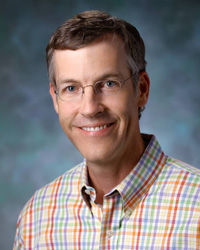Espenshade’s work called ‘brilliantly conceived and flawlessly executed’
The Õµ≈ƒÕµø˙ and Õµ≈ƒÕµø˙ Biology has named , associate professor of cell biology at Johns Hopkins University, the winner of the society’s .

Peter Espenshade
About the award
The Avanti Young Investigator Award in Lipid Research, established by ASBMB’s Lipid Research Division, recognizes outstanding research contributions in the area of lipids by young investigators with no more than 15 years of experience since receiving their degrees (Ph.D. or M.D.). The award consists of a plaque, $2,000, and transportation and expenses to present a lecture at the 2012 ASBMB annual meeting.
According to Peter Devreotes from Johns Hopkins University, the implications of Espenshade’s work are “critical to research into the nature and prevention of cardiovascular disease and stroke.” Moreover, his multifaceted research on how cells regulate both oxygen levels and production of cholesterol “for the first time united the fields of sterol synthesis and oxygen regulation,” said Nobel laureate Michael Brown, with whom Espenshade trained as a postdoctoral fellow. “His work is original, brilliantly conceived and flawlessly executed.”
Randy Hampton, professor of biology at the University of California, San Diego, agreed. “Espenshade has an incredible sense of where to look to find really fascinating and important things – and what to do to turn them into great stories and lines of inquiry.”
After graduating summa cum laude from Princeton University, Espenshade completed his Ph.D. in biology at the Massachusetts Institute of Technology in 1997. During his postdoctoral fellowship with Brown and fellow Nobel laureate Joseph Goldstein at the University of Texas Southwestern Medical Center at Dallas, Espenshade used mammalian cell systems to decipher pathways involved in environmental sensing, in particular focusing on cholesterol homeostasis.
In 2003, he moved to his current position at Johns Hopkins, where he expanded his research to incorporate the fission yeast Schizosaccharomyces pombe as a model system. Espenshade’s ability to “exploit the strengths of both fungal and mammalian model systems to make paradigm-shifting discoveries” led Devreotes to nominate Espenshade for the award. “I have no doubt that his future achievements will be even more prominent.”
Espenshade will receive his award during the Experimental Biology 2012 conference in San Diego, where he will deliver an award lecture. The presentation will take place at 9:55 a.m. April 23 in the San Diego Convention Center.
Enjoy reading ASBMB Today?
Become a member to receive the print edition four times a year and the digital edition weekly.
Learn moreGet the latest from ASBMB Today
Enter your email address, and we’ll send you a weekly email with recent articles, interviews and more.
Latest in People
People highlights or most popular articles

Awards for Alrubaye and Dutta; Strochlic named ass't dean
PSA presents Early Achievement Award for Teaching to Adnan Alrubaye. ASIP honors Anindya Dutta with the Rous–Whipple Award. Drexel names Todd Strochlic assistant dean of curricular integration.

In memoriam: Arnis Kuksis
He was a professor emeritus at the University of Toronto who studied the complex mechanisms dictating lipid metabolism and an ASBMB member for more than 40 years.

Transforming learning through innovation and collaboration
Neena Grover will receive the William C. Rose Award for Exemplary Contributions to Education at the 2025 ASBMB Annual Meeting, April 12–15 in Chicago.

Guiding grocery carts to shape healthy habits
Robert “Nate” Helsley will receive the Walter A. Shaw Young Investigator in Lipid Research Award at the 2025 ASBMB Annual Meeting, April 12–15 in Chicago.

Leading the charge for gender equity
Nicole Woitowich will receive the ASBMB Emerging Leadership Award at the 2025 ASBMB Annual meeting, April 12–15 in Chicago.

Honors for de la Fuente, Mittag and De La Cruz
César de la Fuente receives the American Society of Microbiology‚Äôs Award for Early Career Basic Research. Tanja Mittag and Enrique M. De La Cruz are named fellows by the Biophysical Society.

